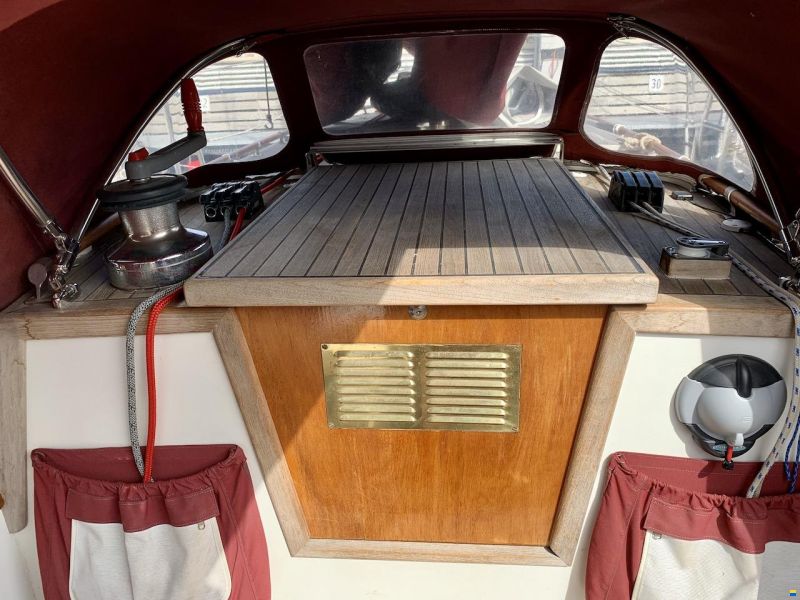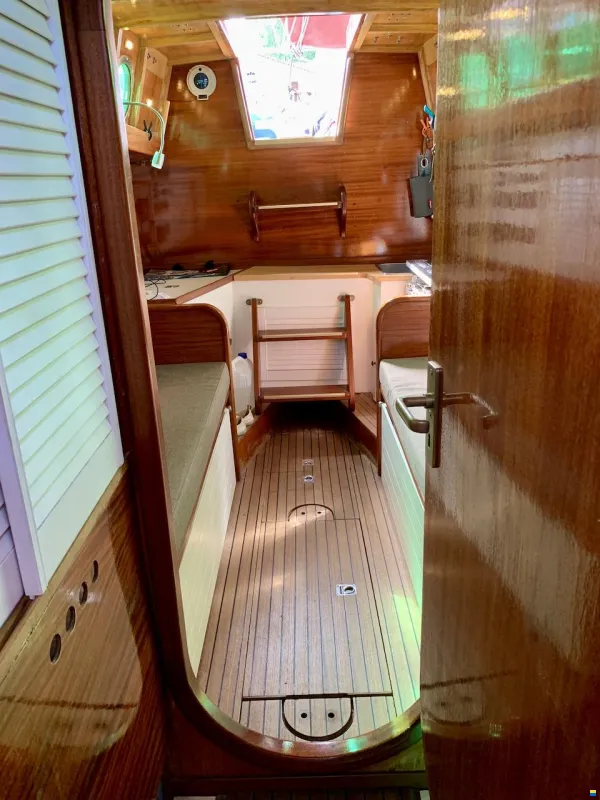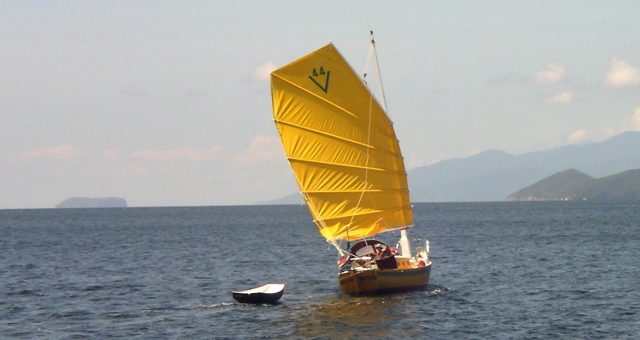
CHRISTMAS NEWSLETTER DECEMBER 2023
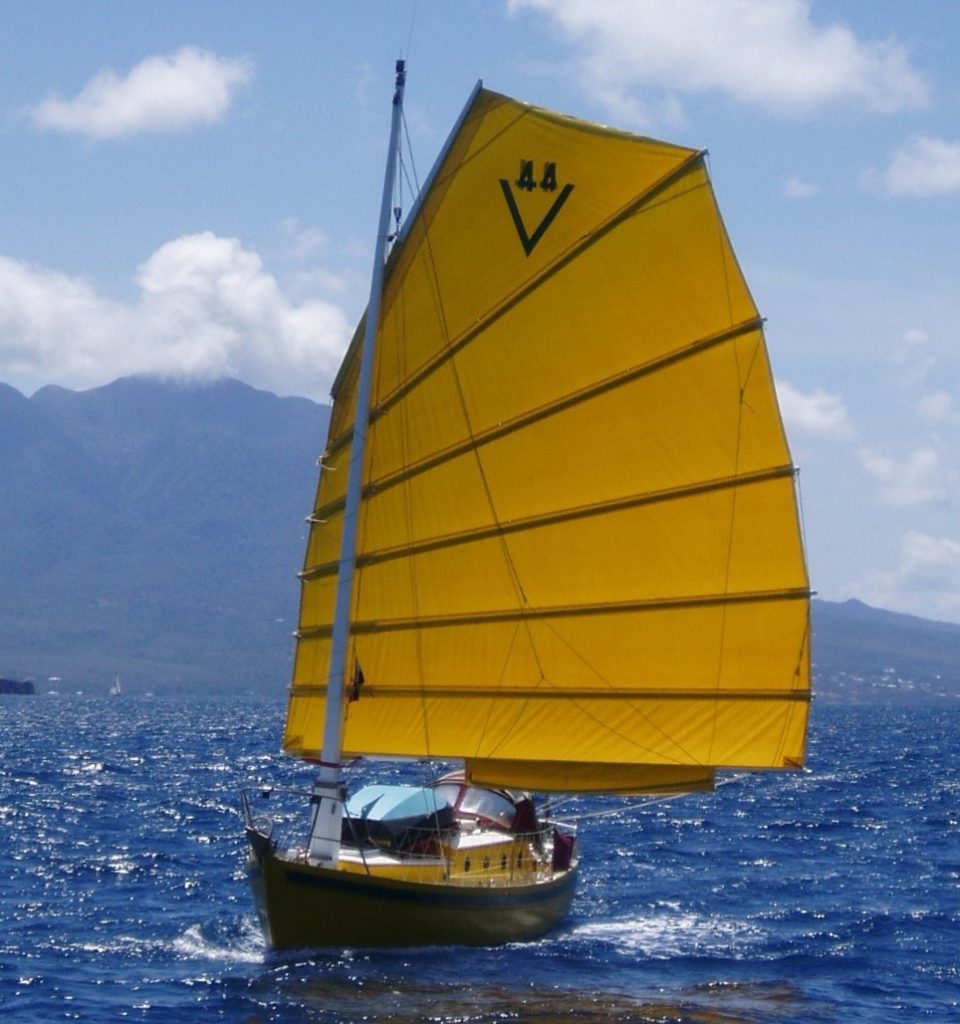
JUNK RIGGED VERTUES
In the Spring Newsletter earlier this year I briefly mentioned three Vertues, whose owners had chosen to rig them with ‘chinese’ junk sails, each set on a single mast. They were called Speedwell of Hong Kong, Jilly and Chu-Fa. However, this autumn I was contacted by Craig and Rebecca, whose boat Caber was also junk rigged. Since then, they have very kindly provided lots more information about Caber, as well as one of the three boats, Jilly, who wasn’t called Jilly at all! We have also been joined by Ute Hilgendag in Germany, with much more information about her boat Chu-Fa. And we are all delighted that Shirley Carter has also written, especially for us, about her beloved Speedwell.
__________________________
SPEEDWELL OF HONG KONG
For the full story about how and why Shirley changed Speedwell’s rig to the modern junk design, please see http://speedwelladventures.com/blog/ She has quietly and gently continued her delightful maritime perambulations, living continuously aboard the boat for two decades, and is the perfect advocate for the junk-rigged maritime gypsy life! Now, I am really grateful to Shirley for kindly writing the following special account of her cruising life so far, for our Newsletter.
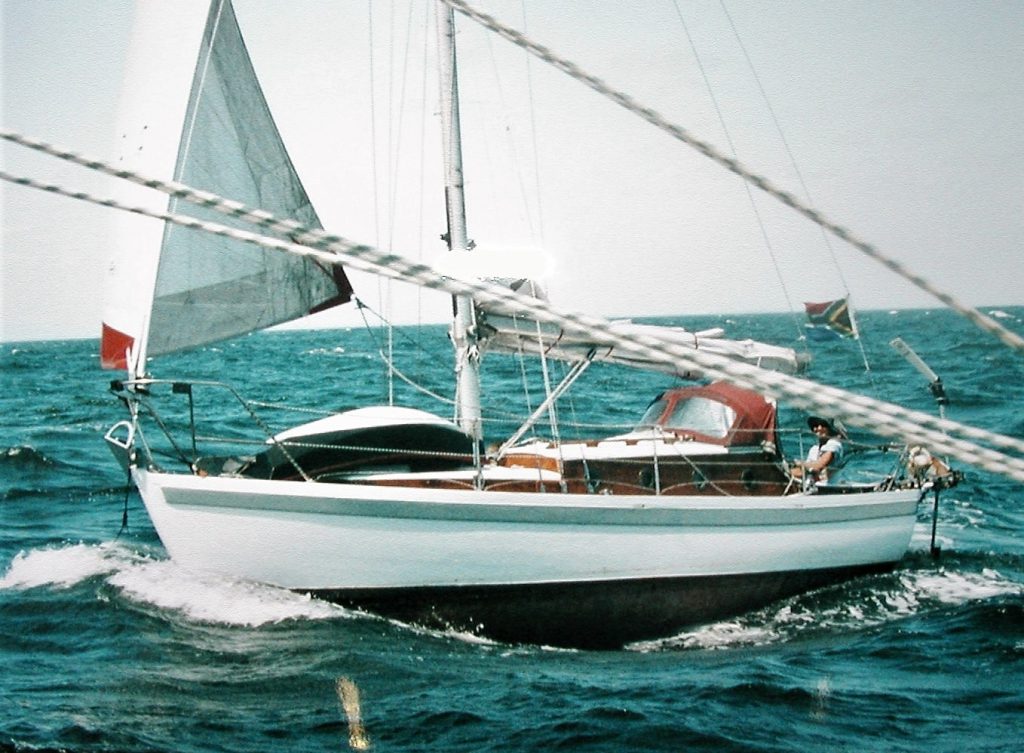
Shirley Carter writes:
“When I first saw Speedwell of Hong Kong she had been swinging to a mooring at Saldanha Bay Yacht Club on the South Western Cape coast of South Africa for quite some time and was in a rather weathered state. Stepping aboard I instinctively knew that I had found the boat I had been looking for. One to take me blue water cruising, and provide a comfortable home for permanently living aboard. The name was still well known in sailing circles at that time (1998) and it seemed quite amazing to me that I could become her new owner.
I spent a year doing an extensive refit which I have written about in some detail in my blog. She was Bermudian rigged and I replaced all the standing rigging, new keel bolts, closed all unnecessary through hull fittings and tried to simplify as much as possible.
After crossing the South Atlantic to Brazil I soon realized that some changes were necessary and after sailing down to Tierra del Fuego with Pete Hill on his junk rigged catamaran, ‘China Moon’, I decided to convert to junk rig. It was a decision that I have not regretted and I would never consider going back to a Bermudian rig.
Vincent Reddish had written some articles about the design of the junk sail that he put on his Vertue, Caber and it seemed to make sense to me to use the same pattern. (See later on for lots more about Caber, and Vincent Reddish) I liked the concept of a low aspect ratio sail with its free-standing mast. Pete made the new mast of wood and it is mounted on deck in a tabernacle which makes it quite easy to lower when necessary just using the halyard and sheet winches. He also made some beautiful laminated teak knees to strengthen and support the tabernacle which is mounted on the keel, well forward of the original mast position. After nearly 20 years of sailing with the junk rig, no further strengthening has been needed and there are no signs of fatigue.
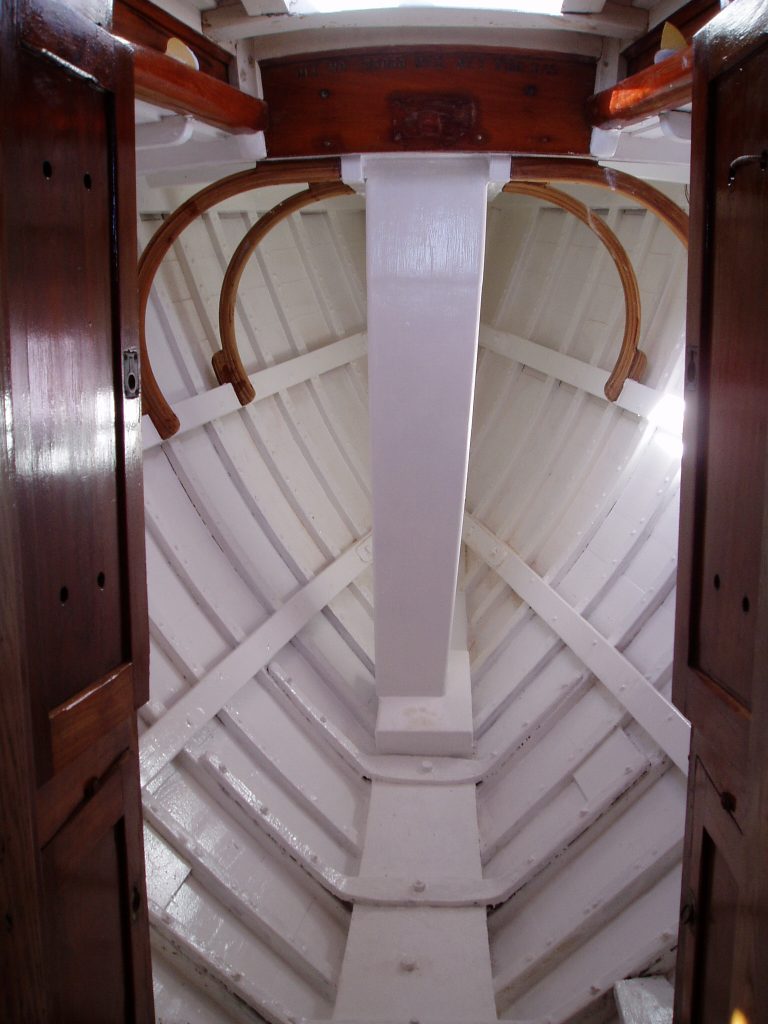
Lower mast tabernacle with elegant laminated teak knees.
The total area of the junk sail is 30 square metres which is the same as the area of the main and jib combined on the previous sail plan. Speedwell is definitely not under-canvassed and the full sail is normally only used in light winds, especially when running downwind. Running backstays are not needed and would be very awkward to handle.
Ease of reefing is probably the most important advantage of the junk rig for a single-handed sailor. Performance to windward is not as good as with the ‘pointy’ sails. We can tack through about the same angle, but don’t manage the same sort of speed. I have been very conservative, in keeping to my original flat sail design as there are fewer things to go wrong with it, but many junk rig enthusiasts have experimented with more shaped sails and can achieve similar performance to traditional sails.
Downwind sailing is where the junk rig really performs magnificently with no need for a whisker pole or any extra lines. She will comfortably sail dead downwind in normal conditions, but personally I prefer to sail a few degrees off when the weather really picks up.
When things start to get too uncomfortable in bad weather, I choose to heave-to if possible, rather than running with it. The sail would already be reefed down as far as necessary and then I would haul the sheet in tightly and point hard in to the wind with the tiller tied off to leeward. We normally settle at about 60deg to windward, and Speedwell‘s full keel holds us relatively comfortably in place, with a smooth slick of water visible as we slowly drift.
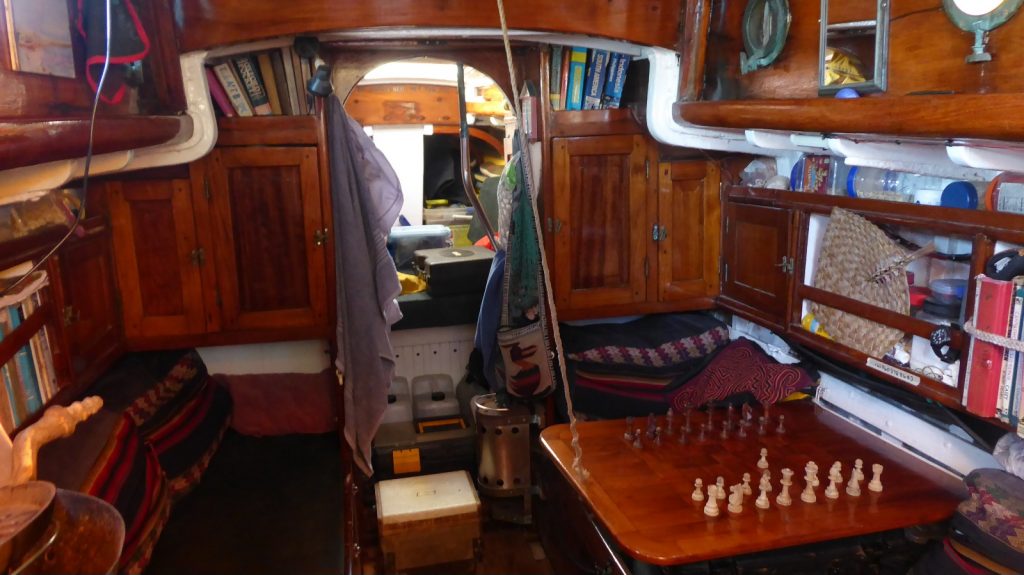
This is what a Speedwell’s main saloon looks like after Shirley’s two decades living aboard: anyone for chess?
On a small boat it is a real advantage to only have a single sail (such as a junk), with no need to store extra canvas below.
I have lived and voyaged very happily on Speedwell for more than 20 years. Probably the most important work that I did, along with the junk rig conversion, was to completely encapsulate the hull with a thick layer of fibreglass and epoxy, much to the traditionalists disgust at the time. This has preserved the integrity of the teak hull through many years of hot and humid tropical sailing.
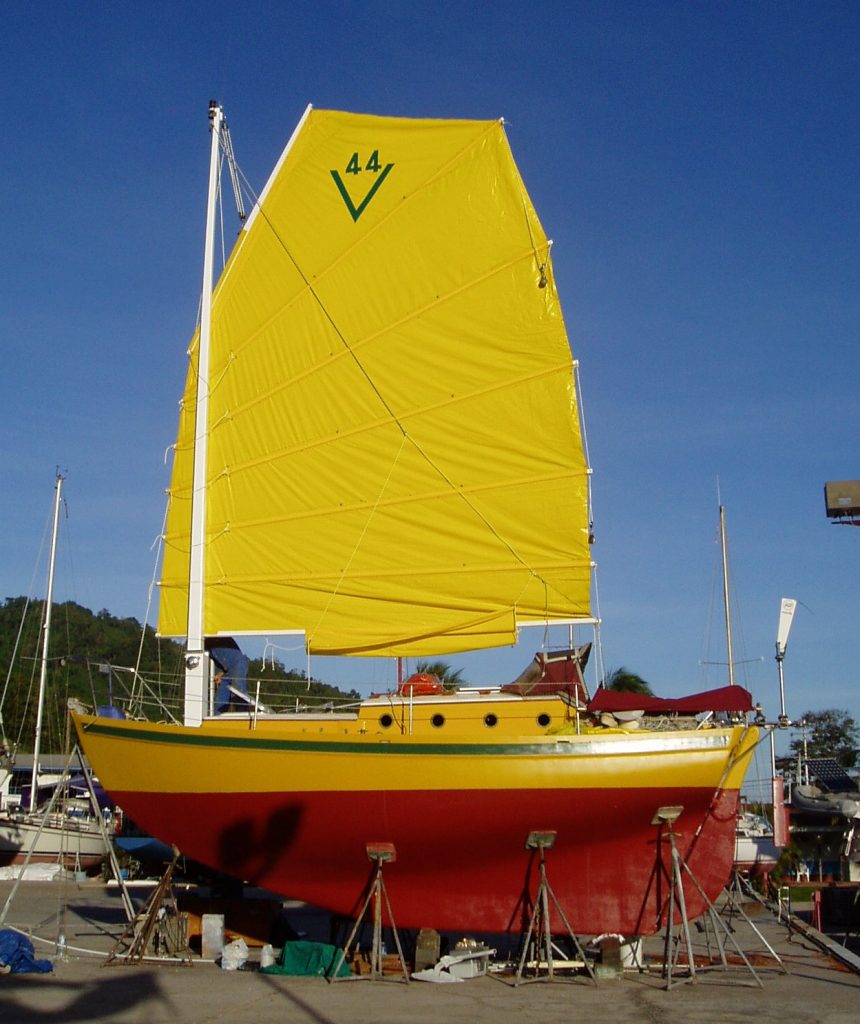
I have kept everything as simple as possible and my energy requirements are minimal. Storage on a small boat is always a problem, as a result, I no longer try to keep the forepeak ready to use for sleeping and it is now where I store my tools, cans of paint and all the other awkward necessities of life at sea.” Shirley Carter.
For more details please refer to my blog speedwelladventures.com

Shirley aboard Speedwell of Hong Kong
_______________
A Baptism in Junk Rig! The Scots Caber.
Rebecca Thorp
“We were not planning to buy a new boat. It was 2002 and we had only had “Cirrus” our 20ft trailer sailer a year, and that was a considerable upgrade on 7 years cruising our Wayfarer dinghy! But Craig loved to look and talk boats and to him there was no better way of spending a holiday weekend than a cruise down the Clyde, a few nights at anchor and home via Inverkip, it’s chandlery and pontoons. Especially interesting to him if there were any boats beginning with V. – Vancouvers, Victorias and of course Vertues!

Caber with her Vincent Reddish junk rig and pilot house.
So, when we came across Caber, a Vertue II in the brokerage at Inverkip it wasn’t long before Craig had the keys in his hand and was aboard removing the washboards for our first peek inside. “I think you will like this” he shouted as he disappeared down the companionway! Well, I did, from the warm woody glow of the Teak and Mahogany joinery, the Pine lined ceiling, the owner’s slippers beside the Taylors cabin heater, the brass oil lamps, a proper heads and galley, bookshelves, and you could stand up in it! The boat was beautiful, and I was smitten.

Caber’s inviting saloon from the totally sheltered companionway.
It didn’t matter that we knew absolutely nothing about Junk rig. A sail built from poly tarp and bamboo battens that had taken the owner Vincent Reddish and this little ship round Ireland was of instant intrigue. There it was, neatly laid out on the chart table, all the inspiration necessary to convince us that this was a boat to have great adventures in: Annie Hill’s “Voyaging on a Small Income”, Hasler/MCleod’s “Practical Junk Rig” and Vincent’s own articles from various magazines including the design and build of his rig for Caber. We were hooked! A trial sail to the Holy Loch for a Junk Rig Rally, where Vincent was speaking about his rig design, just clinched the deal and so began our baptism in Junk Rig!
Two weeks after taking ownership in July 2002 we set off for a 4-week adventure! It was a huge learning curve, with a few incidents that demonstrated Caber’s seaworthiness and the ease of handling and maintaining the boat for us as newbies to Junk Rig. At one point underneath the Mull of Kintyre lighthouse, knocked by a particularly large wave I found myself in the cockpit with the tiller in my hands completely detached from the rudder! This induced major panic and getting it slotted back in was not helped by our rough ride in the tide! But Caber saw us through safely, and the tiller is now securely fixed whenever we go to sea. It transpired that Vincent mostly used the self-steering and had modified the rudder stock with a low friction plastic lining for ease of tiller removal in port!

Rebecca aboard Caber
A week later saw us leaving Canna and heading for Lochboisdale, with a forecast of N/NE 3/4 becoming 5/6 later. It was a gorgeous sparkling blue skied morning and soon we picked up a NE F4 and with 4 panels up reached across the Sea of the Hebrides at a steady 5/6 knots. The wind decided to pick up F6/7 as we approached Lochboisdale and by the time we reached the entrance channel we were down to 3 panels, and I was fighting the tiller quite hard with 2 hands. The ease of dropping to 2 panels was welcome but we were still storming along at 6 knots in an increasingly narrow channel. When I rounded up to drop the sail I didn’t sheet in quick enough, Craig was too slow in lashing down the sail bundle, and the next gust fanned it back up, just as the head blew off the wind and we were once more heading at speed but this time towards the shore. There was a lot of squealing, but we got it sorted and back in control without hitting anything. The finaI debacle on my part was a failure to pick up the last visitor mooring and managing to drop the boat hook over the side on the 3rd attempt!
After a night on anchor watch, thank you Vincent for oversizing the 16kg Delta anchor, the wind dropped in the morning, and we were able to motor over and pick up the visitor mooring. Craig got it first time but did concede that it was difficult as the pickup had wrapped itself round the riser!
The rig had taken a bit of a battering, and some of the battens were broken, so after reading “Practical Junk Rig” and finding out how to “fish” the battens together, a day was spent seizing 4 battens, using up all our spare plastic pipe, canes and most of the cordage. We were confident in the strength of the repairs but decided that until we could replace these old battens, we wouldn’t set sail in anything F6 or over and would reef early.
Keeping to the new rules saw us without further incident sailing up to Rodel, the Shiants and Portree, where were able to get spare garden canes, cordage, and found some plastic pipe washed up on the beach, just in case! Then home via the Inner Sound and the Crinan Canal.

The sheltered for’d cockpit and companionway.
Back home and ashore for the Winter we made a few additions to Caber to remedy the problems we had encountered. We built removeable seats for the cockpit coaming, visibility when sitting helming is now good. We added a downhaul to secure the Yard on the sail bundle from the cockpit. A semicircular rail above the pushpit to keep the sheets out of the way. Finally, we made a new rig. We copied Vincent’s design and his method of construction based on the traditional Chinese method.

We measured out the framework of Boom, Yard, Battens and Bolt rope on the lawn at home using stakes to keep the Boom and Yard in place. Bamboo Battens used in furniture making had rope loops added to the thick ends for running rigging attachments and were secured in place with garden forks and tent pegs! Our new blue Bradshaws tarpaulin was cut to shape, then placed into the framework and sandwiched between the Battens. Sitting on the grass at opposite sides of the sail, we handstitched the sail to the bolt rope using whipping twine. We tried to put some fullness into the lower panels by weighing down with bags of sand and compost! Finally, the battens which were on either side of the sail were fished together with thin pieces of rope put through a hole punched in the tarpaulin and tied at 6 inch intervals. The top battens were fished to give extra length to stop the sheets catching on lower battens. It took about 5 days dodging the April showers and cost £150! We took some video and used that when asked to talk at the next junk rig rally in the Holy Loch.

In the Summer of 2003, we went back out to the Western Isles, with a boat full of toys. Two mountain bikes we adapted to fold so that they would both fit in the quarter berth, a double Klepper folding canvas kayak and some camping gear. It is a tribute to Vincent’s choice of layout that gives Caber an excellent storage capacity! We explored Lewis by bike and then had a 3 day canoe camping trip on Loch Roag. After that we headed South, then through the Sound of Harris and out to St Kilda. The wind dropped on this trip and we got caught in a blanket of Fog, which was a little unnerving as we headed out into the Atlantic. However, Vincent’s “brick” of a GPS ensured we ended up bang in the middle of Village Bay!
Those first years sailing Caber were a joy of discovery and learning, and we have had many more adventures around Scotland and Ireland over the years. There cannot be many anchorages on Scotland’s West coast that we have not poked our nose into. We have had every type of weather, sometimes all in one day, even in the middle of our so-called summer!

Caber‘s fully enclosed cockpit
Vincent’s bespoke Pilot House keeps us out of that weather. The crew can always shelter as can the helm if the self-steering is engaged. We don’t tend to use self-steering much but providing we are sailing or motoring in light winds, the helm can stay dry too with the canopy down and have good standing visibility through Haslers hole!

Craig keeping a lookout!
Non “Junkies” always want to know about performance under sail so here is our view on Caber. Caber can out sail even bigger boats downwind if not flying a spinnaker, and it amuses us when some boats turn their engines on when they realize what has just overtaken them! Having said that boats will often go out of their way to come and have a look at Caber and any comments are usually positive. Caber will happily sail to windward, particularly in a good breeze. She can point as high as some Bermudan rigged boats but performs best slightly freed off, which although a little slower to windward, is more comfortable with less heeling due to a lower centre of effort. A lot of coastal cruisers put their engines on anyway rather than spending a long time thrashing to windward. Caber is not at her best to windward in light winds and sloppy seas, the same conditions again that many coastal cruisers reach for the ignition switch.
In 2023 it was time for another new sail. Tempted by the current trend for cambered panels in junk rig but not wanting to incur the additional stresses placed on the rig and the need for more control lines we continued with Vincents design, as we were not unhappy with the performance and so kept the updating to Dacron Polyester sailcloth and Aluminum battens. It took us quite a while to cut out each panel correctly working outside on the hardstand and using a large sheet of plywood as a giant protractor! The sewing was easier, using a semi-industrial walking foot machine, although the sewing machine couldn’t pull through the weight of the 6m panels and Craig had to support the cloth while I sewed! I think next time rather than doing separate panels I think it would be easier creating one large piece and cutting out the required shape as we did with the tarpaulin. However, we are very pleased with our beautiful new blue sail for Caber.
Next year sees retirement and we hope to have time for more sailing further afield. We still like to get out on the bikes and have acquired a sailing rig for the Klepper which is great fun but hauling it all out of our little ship is getting harder and harder as we suffer the handicaps of age. Very reluctantly we have decided to sell Caber and buy a bigger boat, hopefully it will be junk rigged or convertible to Junk and will be just as seaworthy and as good looking as Caber, though she will be a hard act to follow! Caber’s full specification can be found on our advertisement on the Apolloduck website, which is https://apolloduck.net/742020 . Rebecca Thorp.
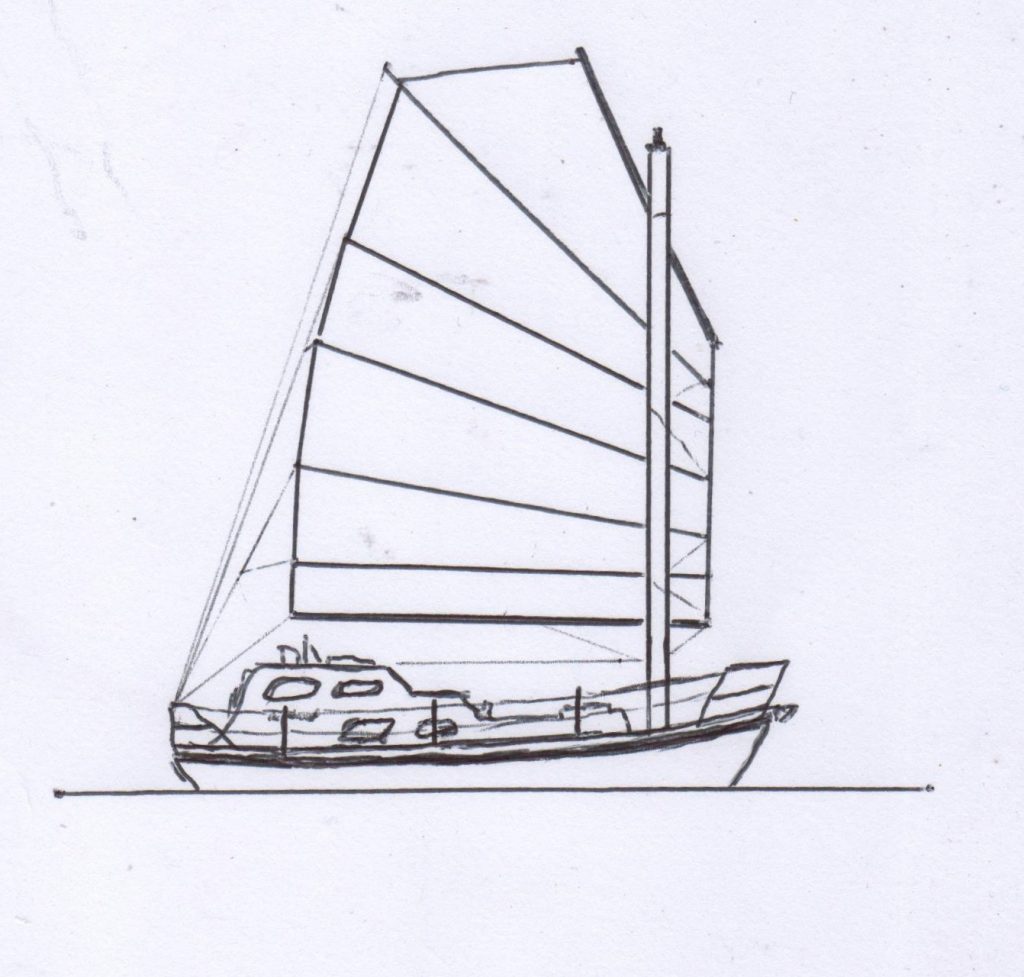
Profile sketch of Caber‘s Sail Plan drawn by Craig.
_________________________
Caber’s First Owner – Vincent Reddish OBE
Craig Simpson
“We are Caber‘s second owners. Caber‘s first owner was Vincent Reddish, OBE and, among many other things, a keen sailor and an eminent academic. A lifelong interest in sailing, in various vessels, had seen him reaching the Isle of Barra on his Leisure 17, Jane. At the height of his academic career, he was Astronomer Royal for Scotland, Director of Royal Observatory, Edinburgh and Regius Professor at Edinburgh University, all at the same time! A true scientist indeed, with a far-reaching enquiring mind, a long history of research and author of several textbooks and scientific papers. Sailing aboard Caber with him in the dark, having attended a Junk Rig sailing rally, my partner Becky and I, had no doubts about his ability to navigate us to port under the night sky!
Early retirement allowed him to focus more on his sailing. Increasing in age, and with angina, he had turned his attention to the ease of handling of junk rigged yachts and to this he then focused his clever mind and research skills in the search for a suitable junk rig for his future sailing. Converting ‘Jane‘s’ Bermudan rig to a series of different junk rig sail plans, based on the river going Chinese junks, he was never happy with their performance. With further research he then focused his attention on the ocean trading junks of China and with studying and taking measurements from historical photographs, he eventually came up with a formula that revealed the subtle sophistication of these rigs, but which belied their simple construction using only simple fractions and lengths of rope for measurements, and to which his Mk IV sail plan was then based.

Average measurements from the sails studied showed Luff and Yard were the same length and 2/3 of Boom length. 5 Battens were the norm and they were the same length as Boom with around 10% flexibility and all connected to a mainsheet, Battens were increasingly angled upwards going from foot to head of sail. Sails had an aspect ratio of 1:1, width of sail matching height of sail. With this aspect ratio and an upper and a lower mainsheet attached to Batten ends, Vincent could induce twist in the fan shaped sail producing camber in the sail. Sail panels between Battens had fullness put into them by little tucks on the leech, fullness decreasing upwards towards a completely flat top panel. Control lines which allowed rig to be moved fore and aft in its vertical plane allowed the Centre of Effort to be moved when necessary. More details of this can be found in his articles in Practical Boat Owner and Junk Rig Association magazines. A trial sail on ‘Jane’ with his MK IV rig based on these measurements proved more successful and he was delighted with its performance.
Vincent now had the ‘icing’, so to speak, to put on his ‘cake’ below, which was to come in the form of a Vertue II, a step up from his Leisure 17, and very much to his taste! Sailing with Vincent on his Vertue II, which he named Caber after he had watched his dog ‘tossing’ sticks! He told us he had long admired the lines of the Vertue, being aware of its reputation, track record and proven excellent sea keeping qualities. This was exactly what he was looking for to do some manageable, more comfortable, extended solo cruising in his retirement, his wife Betty was not a keen sailor. Able to easily accommodate an unstayed mast through a strengthened foredeck, with less maintenance than perhaps a wooden Vertue and within his budget, he commissioned Caber to be built by Bossoms to his specific requirements. Internally he requested 3 berths, in 2 saloon settees with trotter boxes and a quarter berth, forepeak given over to storage, ability to take keel stepped unstayed mast, midships heads and work benches. Externally he requested a bespoke Pilot House covering the forward half of cockpit, (a canvas, fold down canopy over aft half of cockpit was added later by Vincent). This gave good protection when necessary and was characteristic of other junk rigged vessels. A hatch in the Pilot House roof with a rotating ‘Hasler’ type pram-hood spray hood, and all control lines led into Pilot House, completed his requirements. A gimballed hanging/swinging seat below the Pilot House hatch however was soon added, as was self-steering. He also had an over spec. 16kg Delta anchor and a solar panel, [what astronomer could sail without one!] mounted on the Pilot House roof.

Vincent took delivery of Caber in September 1990, as VII 27, and with a scaled-up version of his Mk IV rig matching the Vertue Bermudan rig in sail area and constructed of traditional sturdy bamboo battens and ‘polytarp’ as sail material [modern day inexpensive, but effective, material mimicking the woven bamboo strips originally used by early users of the rig]. He was delighted with the performance of boat and rig in his trial sail down the upper Clyde. He later wrote – ‘In head winds rising from Force 4 to Force 6 she tacked surely along the narrow-buoyed channel, sailing fast close hauled in breaking seas, making 80 degrees between tacks and so well balanced on the helm that the boat would sail to windward without a hand on the tiller. Later experience in a variety of wind strengths and on all points of sailing, has confirmed the rig’s excellent behavior.
Vincent went on in the following years to happily cruise Caber around the West coast of Scotland and to Ireland from her mooring in the upper Clyde, funnily enough on a mooring that was outside our cottage on the shores of the loch – she had been under our noses for several years without realizing it! He was very satisfied with the Vertue II, his choice of specification for her and being under his own effective, easily managed rig. His favourite sitting position was on a seat he built for the companionway and from which self-steering was easily managed. Off the wind and reaching she excelled, and he found it easier, in choppier waters, to sail her a bit freer going to windward. This, along with ease of reefing and sail handling and the low maintenance of the rig, confirmed his choice of boat and rig for his sailing in his later years. In 1993 he sailed her single handed around Ireland, without leaving the cockpit whilst sailing, and reporting average speed, under sail, over this voyage of 4.2kts, testament to what has now become known as the ‘Reddish Rig’. The ‘Reddish Rig’ now holds its place among the various designs that continue to be produced among the junk rig fraternity and detailed in the Junk Rig Association information.
In his last JRA article Vincent wrote – ‘However, age takes its toll, and pensions don’t really buy more as the years go by whatever the politicians pretend; by 2001 looking after Caber had become more than I could do properly [sailing it was still easy] and I sold it to an enthusiastic young couple who, I hope, will get as much pleasure from it as I had. Of course, I was sorry to see Caber go.’ Suffice to say we have had much pleasure”!
_________________________
SUYUAN: ANOTHER JUNK-RIGGED GRP VERTUE
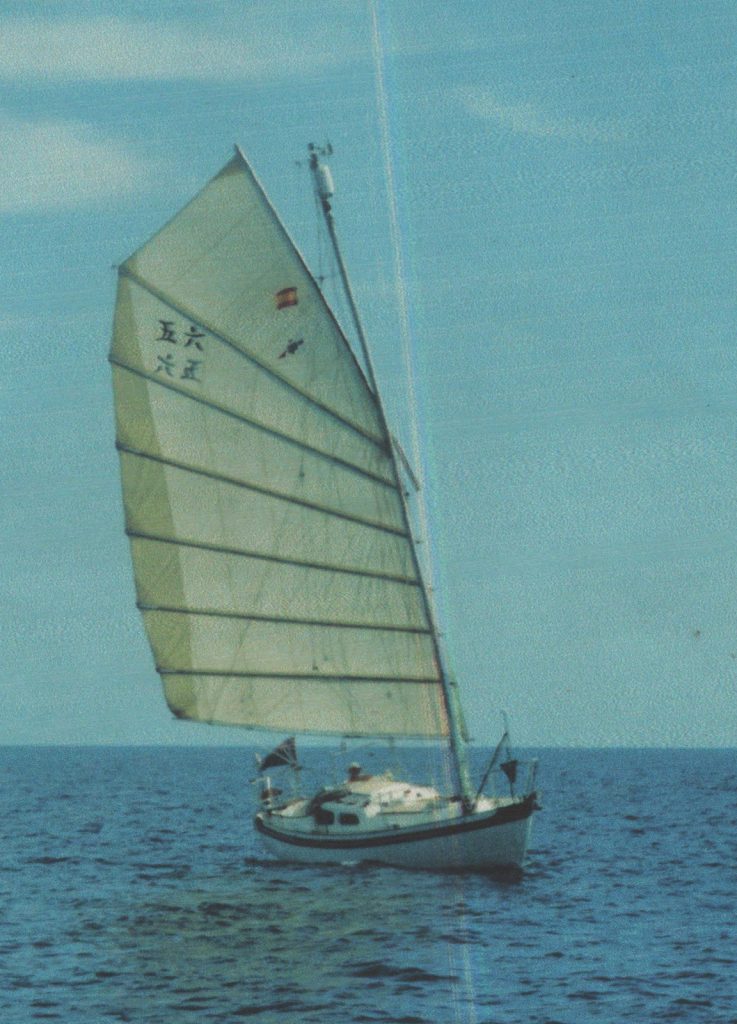
Suyuan footing nicely in a light breeze
I had come across only one picture of Suyuan some years ago and am very grateful to Craig once again for finding, and passing on, some more basic information about this grp Vertue. However we have no idea where she is now, nor who owns her, so if anyone can provide any more information I will post it on her ‘page’ elsewhere on the website. Craig has passed on the information that she was for sale, based in Alicante in about 2004, and owned by David Lutter, having been sailed there from the UK in 1997. Please excuse the rather poor quality of these many times copied photos of this attractive-looking boat.
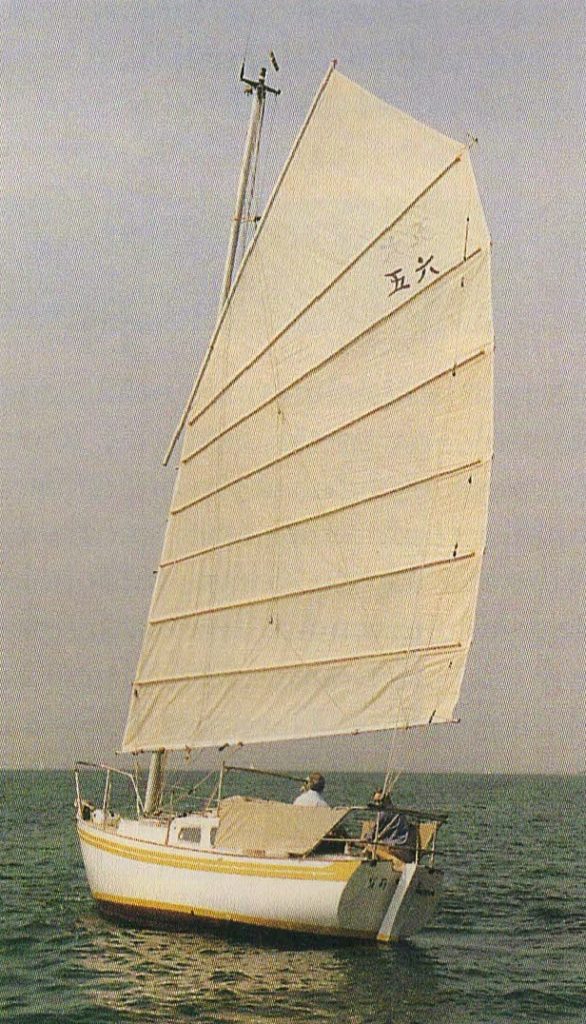
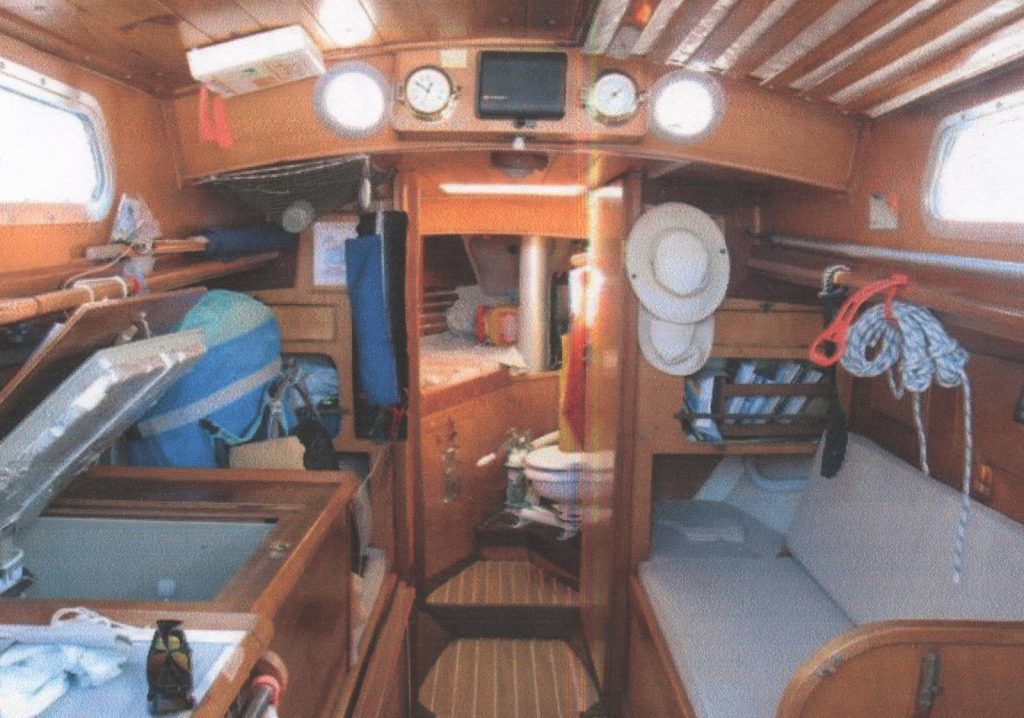
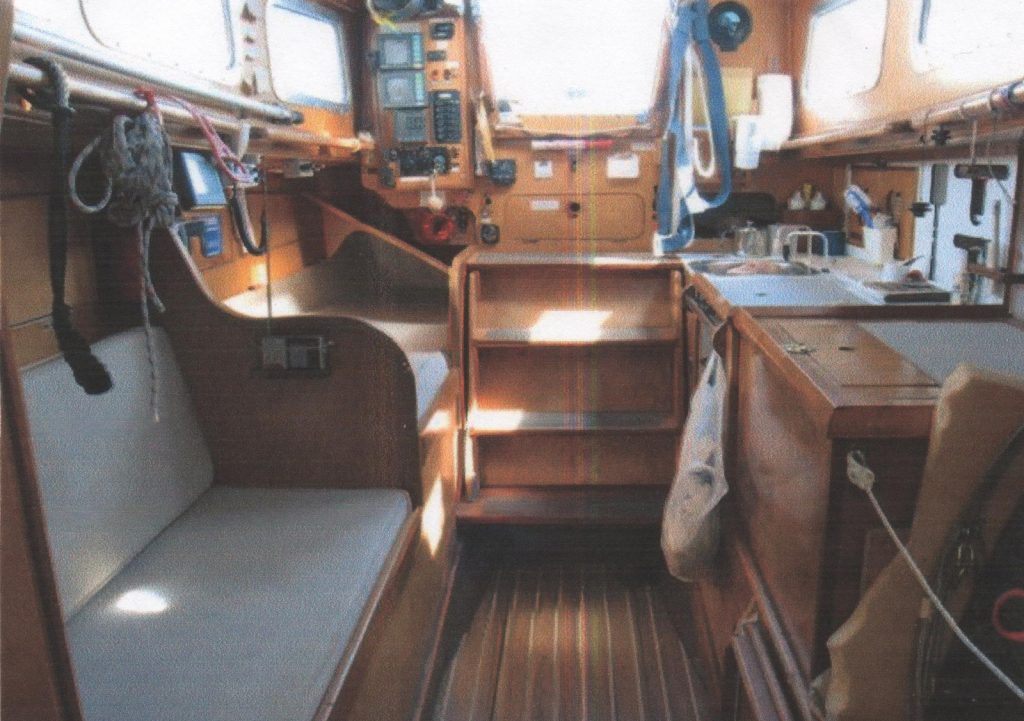
Suyuan’s accommodation shows a fairly conventional, grp Vertue II layout. The giant icebox to port indicates her Mediterranean location! Keen eyes will also have noticed the metal mast stepped just for’d of the heads. But I wonder why it appears to be stepped to port of the centreline? Perhaps someone will write in and let us know.
Suyuan was built by Bossoms in 1988 as VII 21, which is some time before Vincent Reddish commissioned Caber. It would be interesting to know the extent to which the two boats were connected, if at all, in their detailed design and construction at the boat yard. ANY MORE NEWS ABOUT SUYUAN WILL BE GRATEFULLY RECIEVED.
_________________________
CHU-FA: IS THIS THE SHORT-HANDED CRUISING
BOAT OF THE FUTURE?
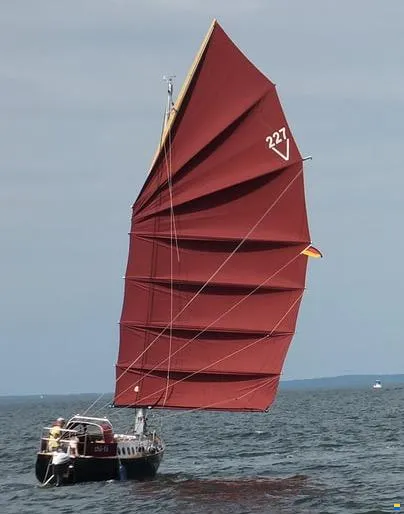
Chu-Fa with her large junk sail.
My Boat: by Ute Hilgendag
“The design drawings by Laurent Giles were purchased in 1999, with sail number V227, and the hull construction was started by Mr. D.R. Sadly he passed away in 2005 and the boat was stored in a boatyard until 2013, when his heirs decided to sell her.
The new owner completed the construction and opted for a junk rig. In 2015 the mast design and calculations were done by Victor Winthertun, from Norway, and the sail was designed and made by Sebastian Henschel (Tuchwerkstatt, Greifswald). At 50 sq m, this is about 20% greater than the standard Vertue rig of 39.95 sq m including masthead genoa. Finally in 2016 Chu-Fa was launched with the official German flag certification.
The hull is constructed of two layers of Western Red Cedar strips in epoxy. Between the layers is a layer of aramid fibre. Inside are strips of carbon fibre. The outside consists of a layer of glass fibre in epoxy, strengthened with epoxy putty, several more layers of epoxy, with dark green topsides paint and underwater antifouling.
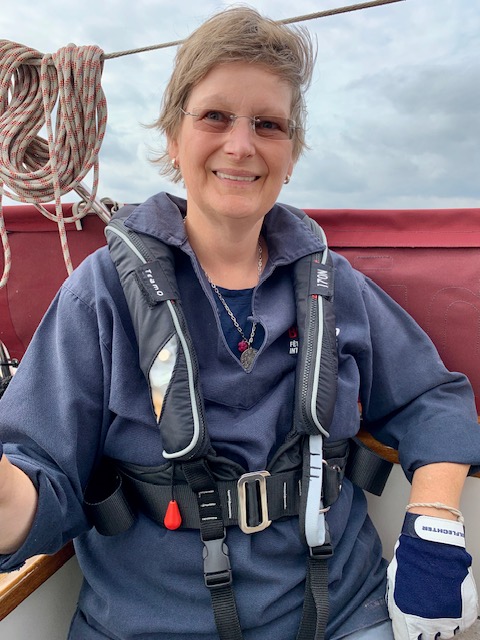
Ute is skipper of Chu-Fa
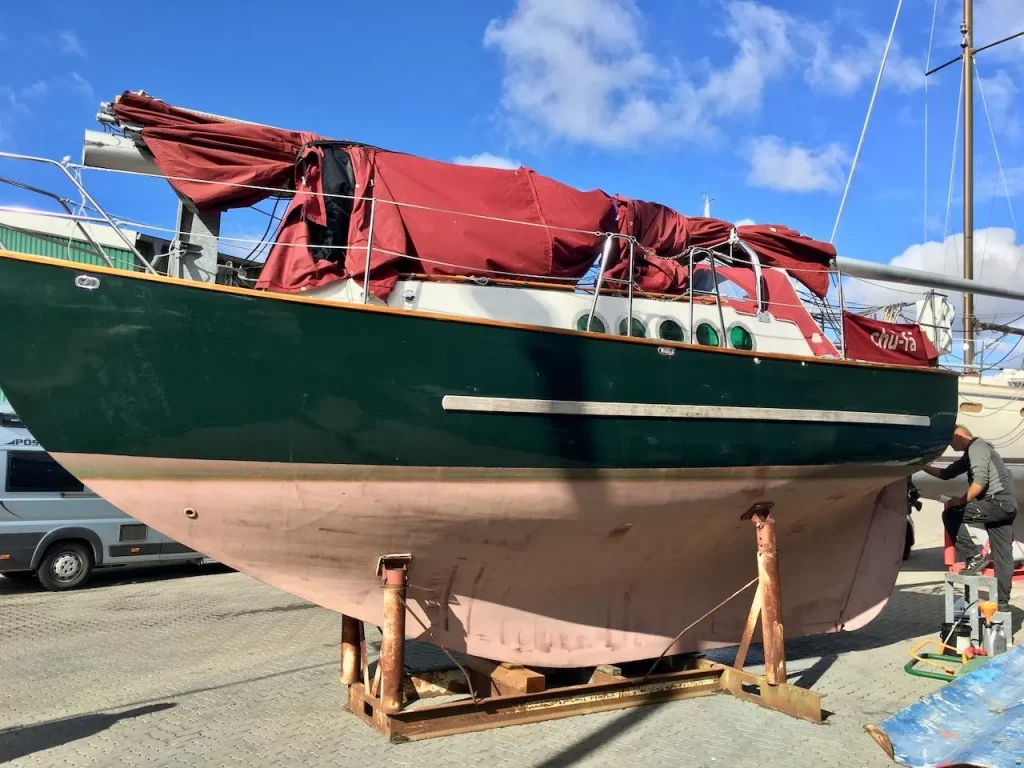
The unmistakeable Vertue hull looks similar to her aluminium sister-ship, Luana, which is also based in northern Germany. However this boat has an unusual ‘rubbing strake’ (as opposed to the signature, thickened ‘sheerstrake’ of most Vertues) designed for lying alongside, and her coachroof is also an unusual design.
The boat has a full teak deck, interior work of mahogany and many brass fittings.
Chu-Fa’s spacious saloon showing the comfortable companionway with no engine box which is often so obtrusive in later Vertues.
From the beginning a 15 hp outboard (with controls from cockpit and connection to rudder) was used and instead of a diesel engine there is a large storage space.
Sailing Properties:
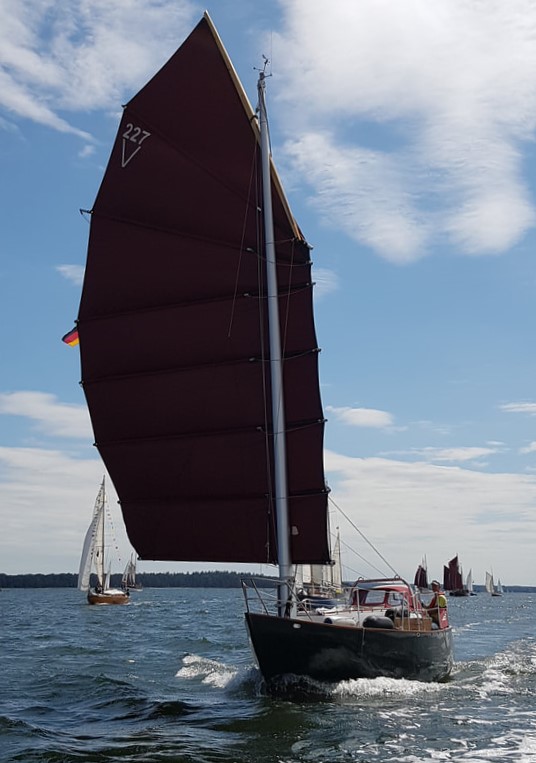
Chu-Fa looks pretty impressive under sail.
The junk rig has some real advantages, especially for a shorthanded crew. Reefing is extremely fast and easy: 5 reefs are possible, and to drop the sail you just throw off the halyard. This makes it possible to sail in light wind as well as stronger winds (we have had as much as force 8 on the Beaufort scale) with just one sail.
The sail is very forgiving, tacking and gybing are done by rudder position only, with no need to ease out or haul in sheets. We can sail as close to the wind as a Bermudan rig, due to the profiled sail, but downwind or on broad reach the junk rig has it´s real advantage. We can reach hull speed even in lighter winds.
The Composting Toilet:
Chu-fa might be the only Vertue with a separation toilet, so I thought I might share our experience with it. The boat had been built using only the best materials, so the previous sea toilet was also made of porcelain and had electric flushing. I told the previous owner that we would probably remodel some things, starting with the removal of the toilet to replace it with a composting toilet. He almost had tears in his eyes because the sea toilet was almost new and he seemed rather proud to have it. But it had no holding tank and that is not even allowed any more in some states around the Baltic, beside the inconvenience in the harbour.
Removing the whole installation was done quickly. The inner diameter of the hoses was already significantly reduced, despite the short time of usage, so we were glad about our decision. There are different models of composting toilets, and we choose a very compact and lightweight model from the German brand of BioToi. The urine bottle holds 10 litres which is sufficient for at least 3 days with use of 2 persons. The solids container is initially filled with organic coco coir and lasts about 21 days of exclusive use by 2 persons.
For urine disposal we always used a normal toilet, which doesn´t smell much, maybe because we flush with a little splash of a water and citric acid mix, which is also good against urine scale. The solid container needed to be emptied only at the end of the season, because we mostly used harbour washrooms. We dumped into a plastic bag and put it into the garbage, but it is also possible to use it as compost in the garden.
We also installed a vent to wick away moisture, including a PC fan with very little energy consumption, and put toilet paper in a separate bin (which is not really needed but prolongs the time until disposal). I have to admit that I was a little skeptical as to whether a separation toilet is suitable for the female anatomy. But it was never a problem, even in bad weather and heeling. We greatly value the option of using the toilet in any given situation, the environmentally friendly system, ease of handling, low costs after purchase and can fully recommend it.
Nevertheless, bearing in mind that the next owner might have different priorities, we kept the seacocks (with hose above the water line) and the entire hardware.
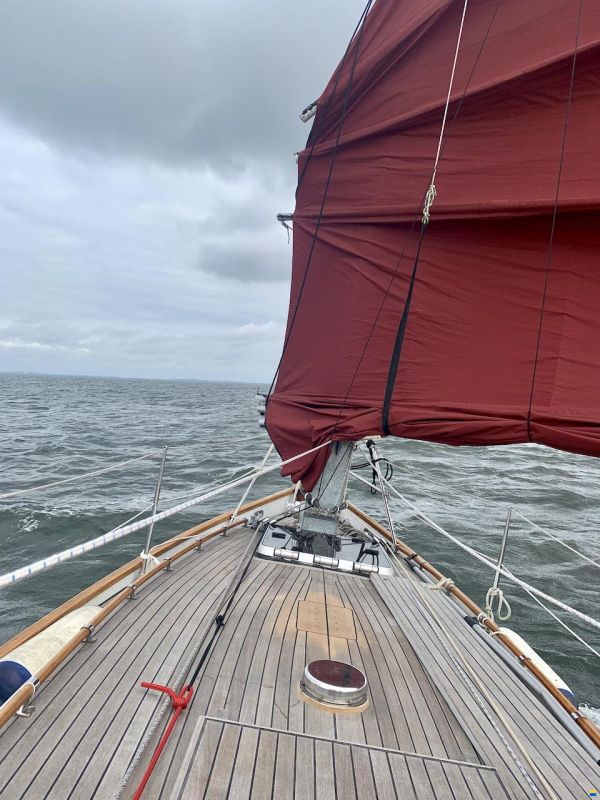
Teak decks. The aluminium mast is stepped in a tabernacle, which makes it easier to lower and there are no deck openings which might become leaky.
HANDLING UNDER SAIL
We usually leave harbour under power until we have some space to set sail. It is not absolutely necessary to point directly into the wind, but it makes it easier to hoist the sail. Everything is operable from the cockpit, but as we are 2 persons, usually one is pulling the halyard standing at the mast, the other one pulling the slack in the cockpit while steering. A better winch would be nice for singlehanded sailing, to speed up the process. Once the desired amount of sail is hoisted, there are 2 parrels and the 2 sheet lines to haul in, which only take seconds to do. There are 2 sheet lines for the different parts of the sail, upper and lower, which makes it possible to control the shape of the sail. If not needed to trim differently they can be operated together in one hand.
Due to the aluminum battens the sail won´t lift or flutter, and the weight of the wooden yard lets it come down by itself, while reefing or when handing completely. If heeling in a gust gets uncomfortable, easing out the sheets will do. Accidental jibes are almost impossible, on a downwind course the boom parrel can let the boom move further forward as the sail is partly forward of the mast and partly on the other side, because the sail is at 90 degrees to the centreline of the boat.
I still consider myself to be a beginner in sailing, but the junk rig is very intuitive and gives time to concentrate on other tasks. By the way, I was hooked by the book “Voyaging On A Small Income” by Annie Hill, who is still sailing a junk rigged, self-built boat in New Zealand. And although I love sailing and Chu-Fa is still the boat of my choice, I have come to realize, that I am not really a skipper at heart. My future extended travelling will be on land, which is why I want to sell her to a good new home.
Chu-Fa is for sale in the European website https://www.boat24.com/de/segelboote/laurent-giles-vertue-ii/detail/523185/ with offers on Euros 35,000 and she is lying ashore on the island of Fehmarn on the German Baltic coast.”
__________________________
OTHER NEWS!
V II 239
As with Chu-Fa, Vertue V 239 is another new boat to be built to the ‘Mk II’ drawings, using pre-shaped structural bulkheads and a strip planking hull system. Her owner and builder, Joop vanSon, has sent some more photographs showing the excellent progress he’s making in his rather tight garage/ workshop.
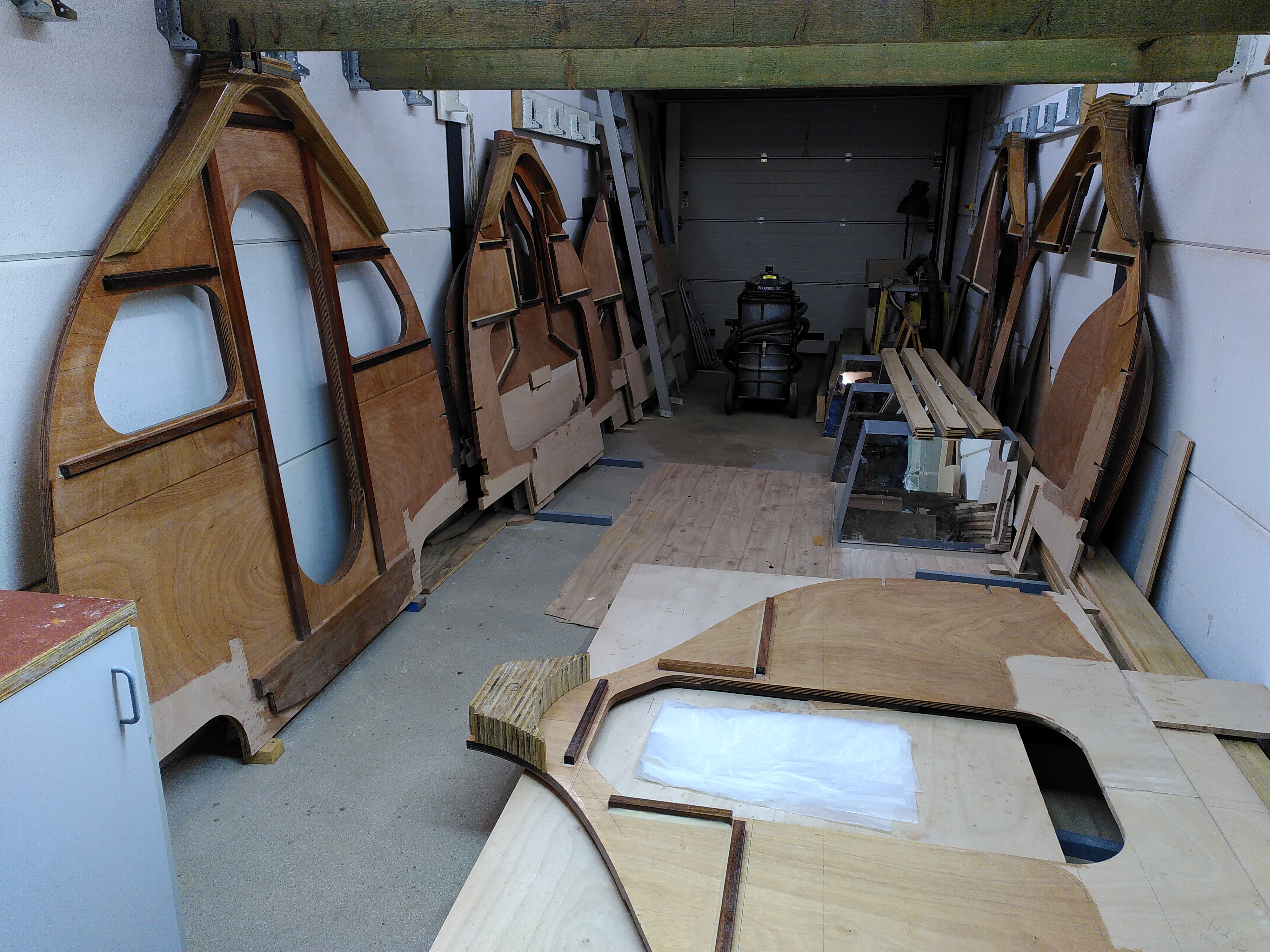
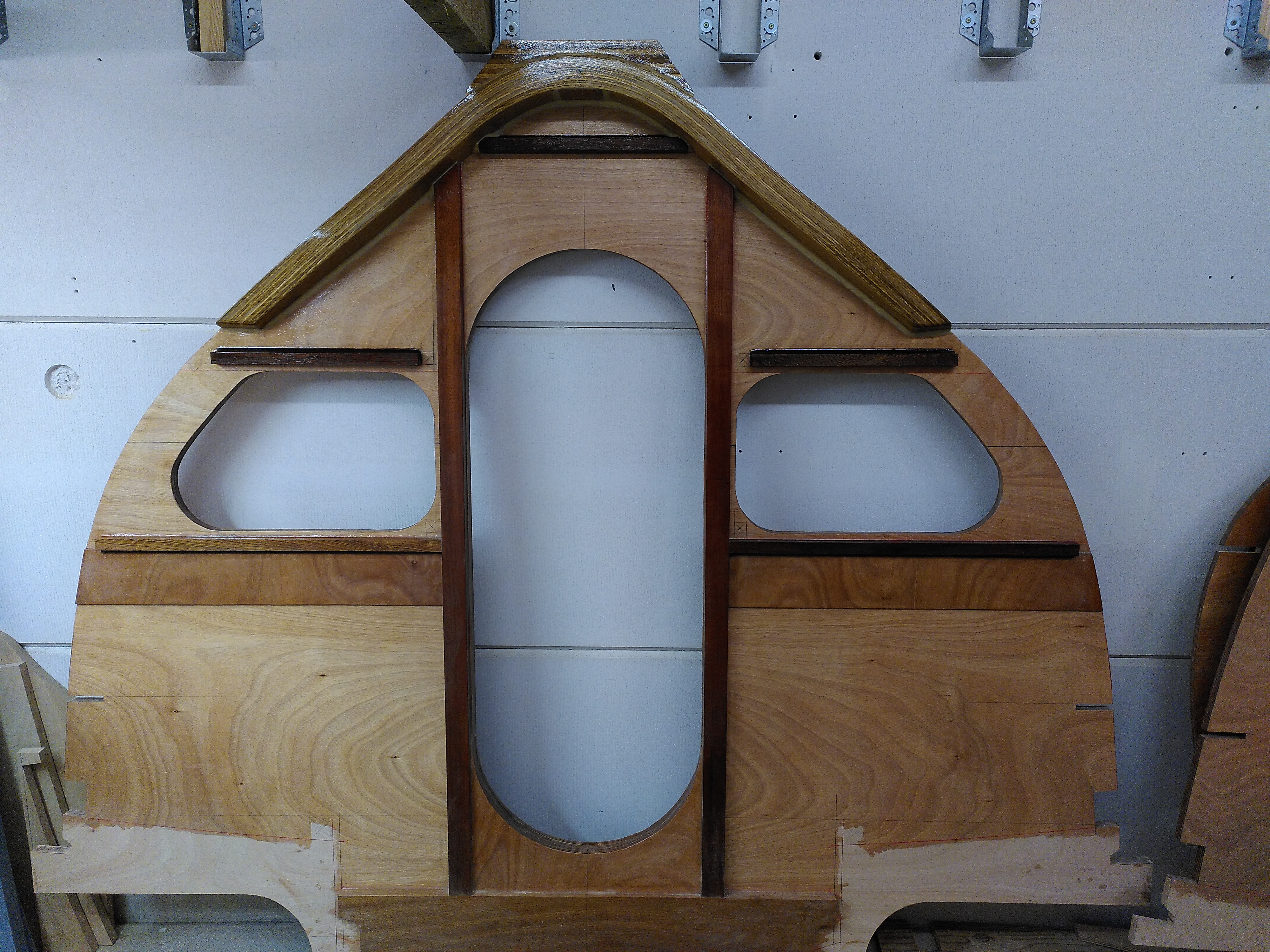
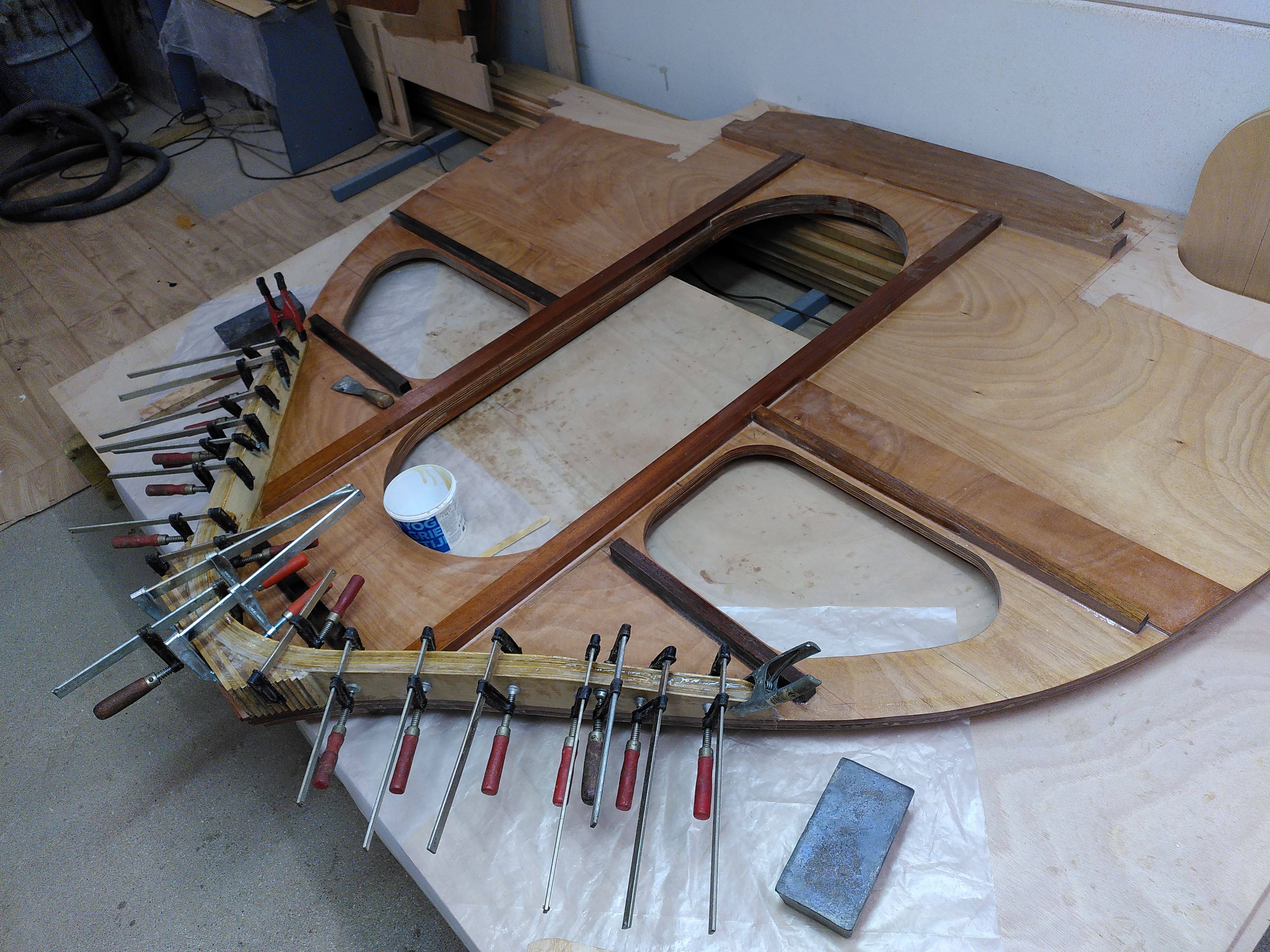
Joop says:
“No boat to be seen yet, only parts.
I am adding/laminating blocks and frames to a number of bulkheads for the keel bolts.
Done 4 so far, 2 more to go.
Then they all get one more layer of epoxy.
Then I am going to construct the building rig.
I don’t have much space so I try to add as much detail to the bulkheads before placing them on the building rig, because then it is going to be a bit cramped.”
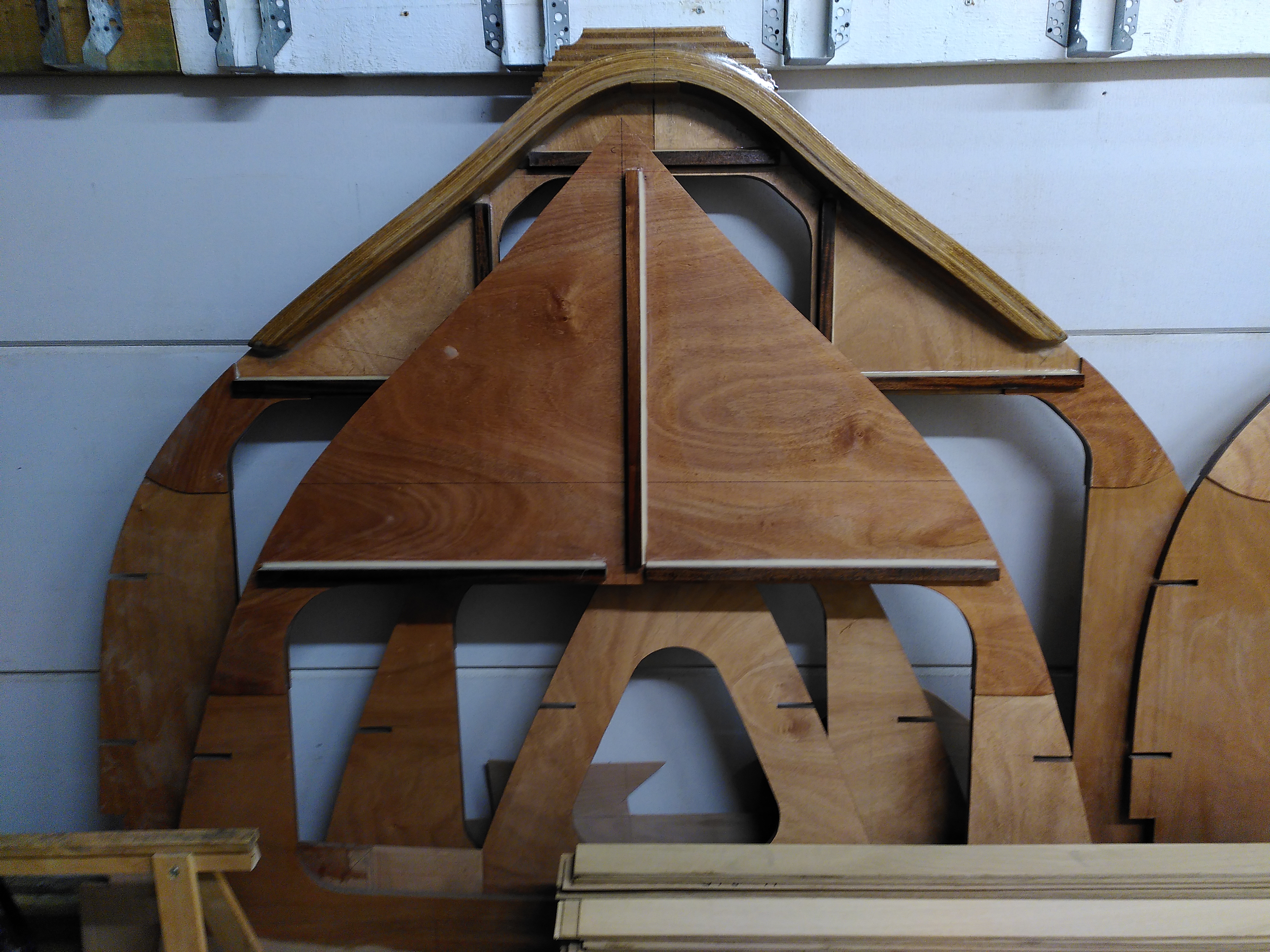
We all wish Joop the best of luck with his amazing project!
_________________________
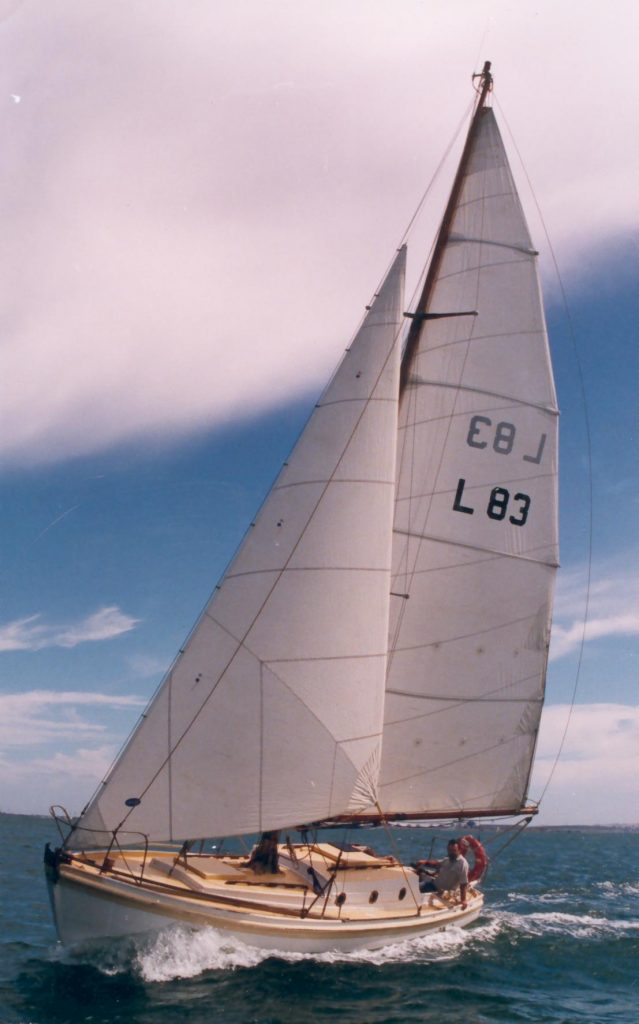
Punjaub
I thought I had better include at least one picture of a bermudan rigged Vertue, in case you thought I had completely lost it!
Last summer I reported on another ‘deep refit’, to be carried out in Australia by Jason Trethowan. As with those other projects, Kandy, Ice Bird and Grace, he has taken on a major task, and here is Punjaub in happier days, looking a picture in Corio Bay, Victoria, Australia. She was then owned by Frank Holden, who has kindly sent this picture and has been in touch with Jason to provide as much support as possible to the project.
I am partly mentioning this because I believe that VertueYachts.com is now entering a new phase in it’s development. When I took over the project of providing some sort of central focus for Vertue Owners from Michael Wodehouse just over a decade ago, I didn’t feel able to run a socially based ‘association’ as such. (I was fully committed to running my small architectural practice at that time) I felt my abilities might be better used to create and develop a more technically based, archival centre for the class and owners, and this is what I have tried to do. However, now that the basis of this has been achieved (although there is much work yet to be done) I have gradually been encouraging more of you, owners and enthusiasts, to contribute to these regular Newsletters, and this month’s edition in particular demonstrates that this is a promising course to follow. But it will only work if several of you continue to feed reports to me, every few months. So if you would like to use this modest website as more of an Association mouthpiece, then let me know, send in some more amazing writing, and I will do my best to continue to put it together for everyone to read and enjoy!
Meanwhile, I would like to thank Shirley, Rebecca and Ute, the three lady junk skippers who have contributed so much fascinating writing about their junk rigged Vertues this month. It has been a complete revelation to me, and the future possibilities for that rig seem to be amazing. Thanks also to Craig for his equally interesting description of one of the key figures in the modern world of junks, Vincent Reddish, and to Frank Holden for all the information about Punjaub, and especially to Joop vanSon for keeping the Vertue self-building tradition alive.
Finally, I would like to say how carefully I have managed to avoid using any silly double-entendres about these special boats and their rigs. There has been absolutely no mention of ‘junkies’, for instance, or even ‘loads of j……’, as these would clearly be in very bad taste. However, it is quite clear to me now that there is much truth in the well-known saying that ‘one woman’s junk is another’s dream ship!’
______________________________
MERRY CHRISTMAS & FAIR WINDS!
Roger



